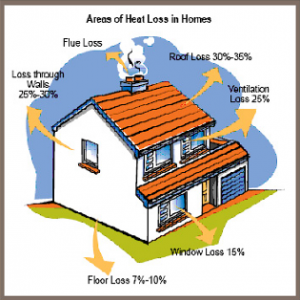 Though it’s only September, winter will soon be here. Most of us don’t want to think about the approaching cold weather, but now is the best time to prepare your home for it. You can save money this winter by preventing heat loss and the warm weather gives you more time to get it done, or be prepared with the items you’ll be needing when that first bone chilling night arrives.
Though it’s only September, winter will soon be here. Most of us don’t want to think about the approaching cold weather, but now is the best time to prepare your home for it. You can save money this winter by preventing heat loss and the warm weather gives you more time to get it done, or be prepared with the items you’ll be needing when that first bone chilling night arrives.
Heat loss from a home is expensive. Though we all can’t install new windows, or spend thousands of dollars installing foam insulation in our walls, there are less expensive ways to prevent heat loss and save money on our heating bills.
The first is by sealing any openings that allow heat to escape. To give you an idea of how such openings affect your heat loss, let’s use an entrance door 3′ wide with a gap at the floor of only 3/8″. Let’s assume the door has no floor sweep, a piece of trim that is mounted to the bottom edge of the door, usually made of a rubber material that seals the opening between the floor and door when the door is closed. Now, draw an imaginary 3″ wide circle on one of your outside walls and imagine that circle to be hole in your wall to the cold winter air outside. That gap in your door equates to the same amount of heat loss as that imaginary hole in your wall. You now have an idea of what your cost is when you multiply all the small openings along windows and doors throughout your home. By the way, if you have air conditioning for summer months, you’re losing cool air, as well.
So, let’s go over the simplest cures and some tips to save money.
Heat Loss Cures
- Door Sweeps – As discussed above. Install or replace as necessary.
- Window Seals – Check window seals (often appearing as a furry attachment along the window edges) for worn gaps, or missing completely. Replace as necessary. For those with older wood windows you should have additional outer storm windows that should be checked. Check the wood frame for gaps at corner joints and that it seats tightly when closed. If they don’t seat properly, you can eliminate gaps by visiting your local home improvement center for a variety of seals that can prevent drafts.
- Caulking – A tube goes a long way. Check along trim work on your outer walls. Floors, doors, and windows. Edges of trim should have no cracks or gaps along the wall. Trim is used to hide a small opening between the wall itself and the door/window frames. Outside air travels from the outer wall, past the frames, and then through the opening in your trim.
- Outlet Insulators – Made of foam, they are installed under the outlet covers on outside walls to provide a better seal from outside air.
- Insulating Stretch-Film – Kits that contain sheets of clear plastic and double-sided tape can be purchased for covering windows to prevent heat loss and reduce drafts. The tape is placed around the trim and the stretch-film is then mounted to the tape. Using a blow dryer, heat then stretches the film to remove wrinkles. It’s crystal clear and when installed properly it is virtually invisible. Adds 80% additional R-value to windows.
- Insulation – Both your attic floor and basement ceiling should have complete insulation from wall to wall, being sure not to cover any roof ventilation that was designed into the home. Fill in any missing areas where insulation should be present. Check the R-value. Many older homes can be found that had previous owners who went the cheap route, if they bothered to install any insulation at all. To find out if you have enough attic insulation, measure the thickness of the insulation. In our area, if it is less than R-38 (Approx. 12 inches of fiberglass or rock wool or 9 inches of cellulose), you would benefit by adding more. In older homes (+ 50 years), attic insulation may have compressed significantly on itself, causing loss of R-value. There is no need to remove this insulation, just add new insulation over it. Basement ceilings should have insulation with an R-value of no less than 25.
Money Saving Tips
- Window Air Conditioners – Removal during winter is best, but if not feasible then do not rely on those prefabricated covers alone to prevent heat loss. Cover the air conditioner with at least two layers of 3 mil plastic sheeting using duct tape to tightly attach the plastic to itself around the air conditioner. Then, place the store bought cover over that, duct taping the edges of the cover to the opening your air conditioner rests in. This will reduce drafts and increase the R-value of the cover.
- Adjust Thermostat – Lower your thermostat a few degrees an hour before bedtime. Under the covers, you won’t notice the lower temperature. To make your life even better there are programmable thermostats that can be set to automatically reduce the temperature at a time of your choosing and then warm the house again before you get out of bed.
- Adjust Vents – If you have a home that has adjustable vents in each room, adjust them to fit your lifestyle and the rooms use. If you have a guest bedroom, or any room in your house that is infrequently used (such as one used for storage), close the vent and the door to the room. The heat will bypass that room and travel to an area of the home where it can be put to better use. Other rooms should be adjusted, as needed. It may take some experimenting and some trial and error, but eventually, you’ll find the correct adjustment for every room in your home.
- Thermostat Covers – If you have kids that can’t follow your rules about the thermostat setting on days you are at work and they are home from school, invest in a locking thermostat cover. It will probably pay for itself during the two weeks of their Christmas vacation.
- Ceiling Fans – Set on the lowest rotation. The air should be drawn upward, toward the ceiling. This moves warm air along the ceiling to the walls, pushing it to the floor where it will again rise, but produce no breeze that would create a cooling effect.
- Train Your Kids – “Close the door! I’m not paying to heat the neighborhood!” How many of us remember hearing that from our parents. With 5 brothers and sisters in my childhood home, it seemed I heard that every 10 minutes in the winter until my mother got devious on us. We never got an allowance and were expected to do our chores without reward. So, it was shock to us when my mother gathered us up after the old man turned on the heat one winter to inform us we would all be getting $2.00 each week for an allowance. It would only be during the months that the heat was on. There was one catch to the deal. Any time she had to call us to shut the door – fully – coming in or going out, she would deduct 25 cents from our allowance. If we went over the $2.00 for the week the additional infractions would be applied to the following weeks. No problem, we all thought. She kept meticulous notes on all of us.
That entire winter I earned a grand total of $2.25 and it all came shortly before the heat was turned off. My siblings didn’t fair much better. But, it made an impression. The following winter, after a month of the heat being on, she disbanded the allowance claiming money was in short supply (which was true) and all of us earning our $2.00 was putting a strain on paying the bills. Even so, after that, rarely did we hear, “Shut the door!”
We were all trained.
Disclaimer: On January 4, 2016, the owner of WestEastonPA.com began serving on the West Easton Council following an election. Postings and all content found on this website are the opinions of Matthew A. Dees and may not necessarily represent the opinion of the governing body for The Borough of West Easton.







